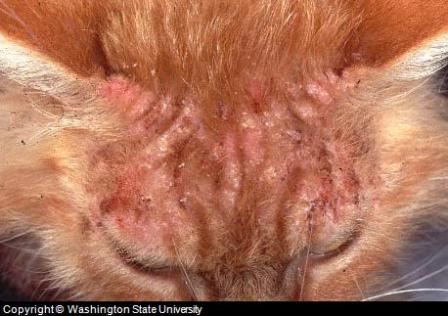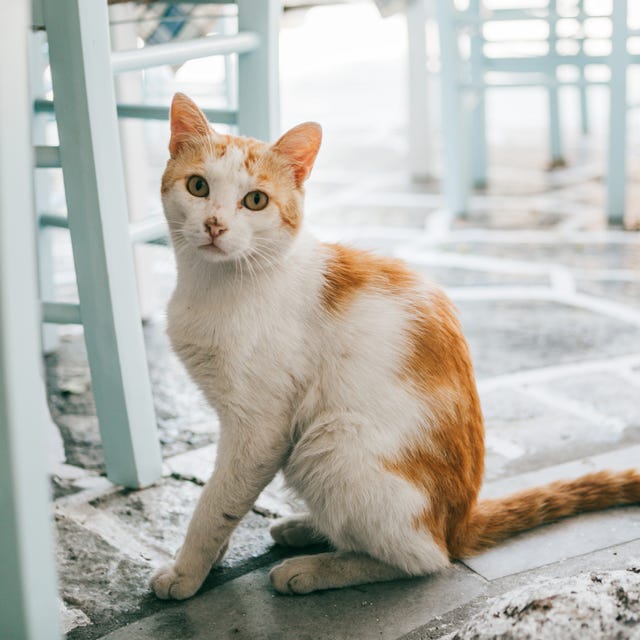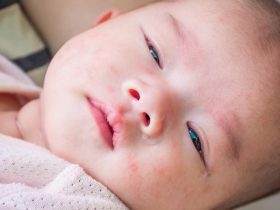To treat dry skin on cats, provide proper hydration and use a vet-approved moisturizing shampoo. Ensure a balanced diet rich in essential fatty acids.
Dry skin in cats can cause discomfort and lead to more severe skin issues if not addressed promptly. Proper hydration is crucial for maintaining healthy skin. Cats often do not drink enough water, so wet food can help increase their fluid intake.
A balanced diet rich in essential fatty acids, such as omega-3 and omega-6, can also improve skin health. Regular grooming helps remove dead skin cells and distribute natural oils. Always consult your veterinarian before introducing new products or supplements to ensure they are safe and effective for your cat. Proper care and attention can keep your cat’s skin healthy and free from dryness.

Credit: www.amazon.com
Identifying Dry Skin In Cats
Dry skin in cats can lead to discomfort and itching. Identifying dry skin early helps in providing quick relief to your feline friend. Learn the common symptoms and causes of dry skin in cats.
Common Symptoms
Recognizing the symptoms of dry skin is the first step. Common signs include:
- Flaky Skin: Visible flakes similar to dandruff.
- Itching: Your cat scratches more than usual.
- Red Patches: Inflamed areas on the skin.
- Hair Loss: Bald spots appearing on the fur.
- Excessive Grooming: Your cat licks certain areas often.
Causes Of Dry Skin
Understanding the causes helps in preventing and treating dry skin. Here are some common causes:
- Diet: Nutritional deficiencies affect skin health.
- Weather: Dry air can lead to skin dryness.
- Allergies: Reactions to food or environmental factors.
- Parasites: Fleas or mites can cause skin issues.
- Medical Conditions: Issues like diabetes affect the skin.
| Symptom | Possible Cause |
|---|---|
| Flaky Skin | Dry Air, Poor Diet |
| Itching | Allergies, Parasites |
| Red Patches | Allergies, Infections |
| Hair Loss | Medical Conditions |
| Excessive Grooming | Stress, Allergies |

Credit: www.amazon.com
Dietary Solutions
Dry skin on cats can be uncomfortable and lead to other health issues. One effective way to manage this problem is through dietary solutions. Feeding your cat the right nutrients can significantly improve their skin condition. This section will explore two key areas: Omega-3 Fatty Acids and the Importance of Hydration.
Omega-3 Fatty Acids
Omega-3 fatty acids are vital for your cat’s skin health. These nutrients help reduce inflammation and keep the skin moist. You can find Omega-3 in fish oils like salmon and tuna. Always choose high-quality fish oils for your pet.
Another source of Omega-3 is flaxseed oil. It’s a plant-based option that some cats prefer. You can add a small amount to your cat’s food. Start with a tiny dose and gradually increase it.
Here is a simple table showing sources of Omega-3 fatty acids:
| Source | Type |
|---|---|
| Salmon Oil | Animal-based |
| Tuna Oil | Animal-based |
| Flaxseed Oil | Plant-based |
Hydration Importance
Keeping your cat hydrated is crucial for their skin. Cats often don’t drink enough water. This can lead to dry skin. Make sure your cat always has fresh water available.
Wet food can help increase your cat’s water intake. Wet food contains more moisture than dry kibble. Adding a bit of water to their dry food can also help.
Consider using a water fountain. Many cats prefer running water. A water fountain can encourage them to drink more.
- Provide fresh water daily.
- Offer wet food options.
- Use a water fountain.
Proper hydration keeps your cat’s skin smooth and healthy.
Topical Treatments
Cats with dry skin can be uncomfortable and itchy. Treating dry skin involves various topical treatments. These treatments can soothe and hydrate your cat’s skin. Below, we explore some effective options.
Moisturizing Shampoos
Using a moisturizing shampoo can help relieve your cat’s dry skin. Look for shampoos with ingredients like oatmeal and aloe vera. These ingredients are gentle and nourishing. They provide moisture and reduce irritation.
Here are some benefits of using a moisturizing shampoo:
- Hydrates the skin
- Reduces itching
- Removes dirt and allergens
Make sure to rinse the shampoo off thoroughly. Leftover shampoo can cause further dryness or irritation.
Natural Oils
Natural oils are another great option for treating dry skin. They provide deep hydration and are usually safe for cats.
Some effective natural oils include:
| Natural Oil | Benefits |
|---|---|
| Coconut Oil | Moisturizes and soothes the skin |
| Olive Oil | Rich in vitamins and antioxidants |
| Fish Oil | Contains Omega-3 fatty acids |
Apply a small amount of oil to your cat’s skin. Massage it gently to ensure even distribution. Avoid using too much oil to prevent a greasy coat.
Regular use of natural oils can improve your cat’s skin health. Always consult your vet before starting any new treatment.
Environmental Adjustments
Treating dry skin on cats can involve several approaches. One key method is making environmental adjustments. These changes can help your cat’s skin stay healthy. Below are some effective strategies.
Humidifier Use
A humidifier can add moisture to the air. This helps prevent your cat’s skin from becoming dry. Place a humidifier in the room where your cat spends the most time. Run it daily to keep the air moist. This simple tool can make a big difference.
Choose a humidifier with an automatic shut-off feature. This ensures safety and saves energy. Clean the humidifier regularly to avoid mold and bacteria buildup. A clean humidifier works better and keeps the air healthy for your cat.
Temperature Control
Maintaining the right temperature in your home helps your cat’s skin. Keep the room temperature stable. Avoid sudden changes. Cats prefer warm and cozy spaces. Cold air can dry out their skin.
| Temperature | Effect |
|---|---|
| Too Cold | Dries out skin |
| Too Hot | Causes discomfort |
| Stable | Keeps skin healthy |
Use a thermostat to keep track of the temperature. Aim for a range between 68°F and 72°F. This range is comfortable for most cats. Check the temperature often. Adjust as needed to keep your cat happy and healthy.
Regular Grooming
Regular grooming is essential for maintaining your cat’s skin health. It helps reduce dryness and keeps their coat shiny. Below are some effective techniques to keep your cat’s skin hydrated and healthy.
Brushing Techniques
Regular brushing removes dead skin cells and distributes natural oils. Use a soft-bristled brush to avoid irritating the skin. Brush your cat at least once a week. For long-haired breeds, brush daily to prevent matting. Always be gentle to prevent skin damage.
Use the following steps for effective brushing:
- Start with the head and move towards the tail.
- Brush in the direction of hair growth.
- Check for any signs of irritation or parasites.
Bathing Frequency
Bathing your cat can help remove dirt and allergens. But over-bathing can strip natural oils, causing dry skin. Bathe your cat once a month at most. Use a cat-specific shampoo to avoid skin reactions.
Follow these steps for a successful bath:
- Fill the tub with lukewarm water.
- Wet your cat gently using a cup or sprayer.
- Apply a small amount of cat shampoo.
- Rinse thoroughly to remove all shampoo.
- Dry your cat with a soft towel.
Monitor your cat’s skin condition regularly. Adjust grooming habits as needed to maintain skin health.
Veterinary Care
Dry skin on cats can cause discomfort and irritation. Seeking veterinary care ensures your cat receives the best treatment. Vets can diagnose the root cause and recommend effective treatments. Below are key steps for when to see a vet and potential medications.
When To See A Vet
Observe your cat closely for any signs of dry skin. These signs include flaking, redness, or excessive scratching. If the dry skin persists or worsens, it’s time to see a vet. Your vet can check for underlying issues like allergies or infections. Early intervention can prevent more serious problems later.
- Persistent dry skin
- Redness or inflammation
- Excessive scratching or grooming
- Visible flakes or dandruff
Possible Medications
Vets may prescribe various medications to treat dry skin in cats. These medications target the root cause of the issue. Below is a table outlining common medications and their uses:
| Medication | Use |
|---|---|
| Antibiotics | Treat bacterial infections causing dry skin |
| Antifungals | Combat fungal infections |
| Antihistamines | Reduce allergic reactions |
| Omega-3 supplements | Improve skin health |
- Follow the vet’s instructions carefully.
- Administer medications as prescribed.
- Monitor your cat for any side effects.
- Schedule follow-up visits if needed.
Addressing dry skin early can make a big difference in your cat’s comfort. Always consult your vet for the best care plan.
Preventive Measures
Preventing dry skin in cats is essential for their overall health. By taking proactive steps, you can ensure your cat’s skin remains hydrated and healthy. Below are some effective preventive measures to keep your cat’s skin in top condition.
Balanced Diet
A balanced diet is crucial for maintaining healthy skin in cats. Ensure your cat’s food contains essential fatty acids. Omega-3 and Omega-6 fatty acids help keep the skin hydrated. Look for high-quality cat food that lists these nutrients. Avoid feeding your cat low-quality food with fillers and artificial additives. Fresh water is also vital. Keep your cat’s water bowl clean and filled at all times.
Consistent Grooming
Regular grooming helps keep your cat’s skin healthy. Brush your cat’s fur daily to remove dirt and loose hair. This helps distribute natural oils across the skin. Use a grooming tool that suits your cat’s coat type. For long-haired cats, a comb with wide teeth works best. Short-haired cats benefit from a soft-bristle brush.
Bathing your cat occasionally can also help. Use a cat-friendly shampoo to avoid irritating the skin. Do not bathe your cat too often, as this can strip natural oils. After bathing, ensure your cat is thoroughly dried to prevent irritation.
Monitor your cat’s environment for allergens. Dust, pollen, and mold can irritate your cat’s skin. Clean your home regularly and use air purifiers if needed. Keeping your cat’s living space clean reduces the risk of dry skin.

Credit: www.cat-health-guide.org
Homemade Remedies
Dry skin can make your cat uncomfortable. Homemade remedies can help soothe their skin. These remedies use simple, safe ingredients found at home.
Diy Treatments
Homemade treatments are easy to prepare. You can create natural solutions for your cat’s dry skin.
- Oatmeal Bath: Blend oatmeal into a fine powder. Mix it with warm water. Bathe your cat in the mixture for 5-10 minutes.
- Aloe Vera Gel: Use pure aloe vera gel. Apply a small amount to the dry areas of your cat’s skin.
- Coconut Oil: Warm a teaspoon of coconut oil. Gently massage it into your cat’s skin. Use a little amount to avoid greasy fur.
Safe Ingredients
Not all ingredients are safe for cats. Use only those that are non-toxic and gentle.
| Ingredient | Benefits | Application |
|---|---|---|
| Oatmeal | Soothes and moisturizes | Use in baths |
| Aloe Vera | Reduces inflammation | Apply gel directly |
| Coconut Oil | Moisturizes skin | Massage into skin |
Always check with your vet before trying new treatments. Your cat’s safety is the priority.
Frequently Asked Questions
What Causes Dry Skin On Cats?
Dry skin on cats can be caused by allergies, dehydration, poor diet, or environmental factors. It’s important to identify the underlying cause.
How Can I Moisturize My Cat’s Skin?
You can moisturize your cat’s skin by using a vet-recommended moisturizer or adding omega-3 fatty acids to their diet.
Are There Home Remedies For Cat Dry Skin?
Yes, home remedies include coconut oil, fish oil supplements, and proper hydration. Always consult your vet first.
Is Diet Important For Cat Skin Health?
Yes, a balanced diet rich in omega-3 and omega-6 fatty acids helps maintain healthy skin and coat.
Conclusion
Treating dry skin on cats requires care and attention. Use moisturizing shampoos and ensure proper hydration. Regular vet visits help identify underlying issues. With these steps, your cat can enjoy healthier skin and a happier life. Always prioritize your pet’s well-being for the best results.








